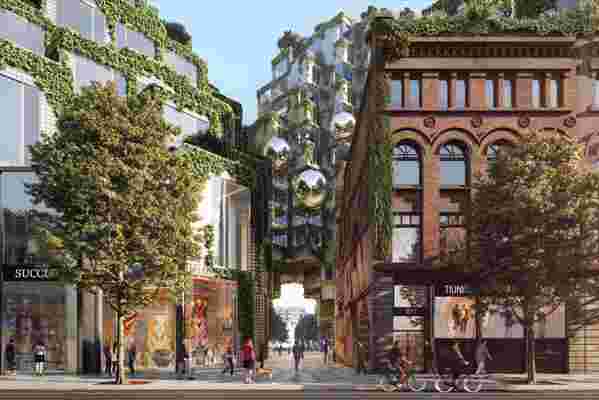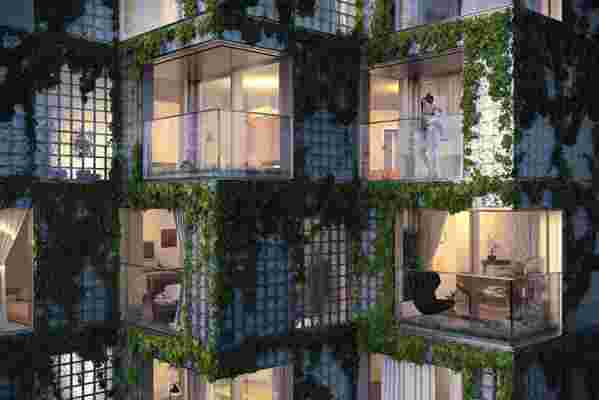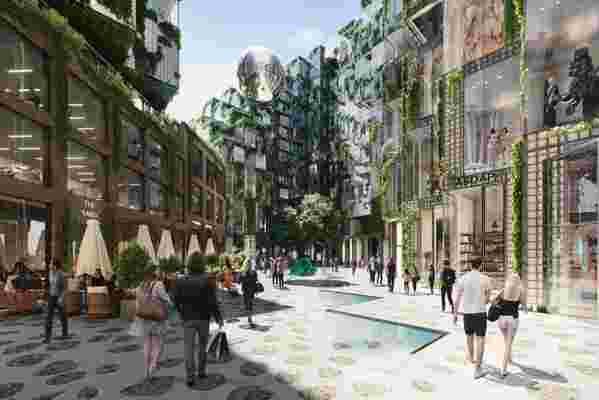Toronto will soon have its own version of Moshe Safdie’s iconic Habitat 67 housing complex. The architect's thesis project, which was constructed for Expo 67 in Montreal and is still occupied today, has inspired AD100 architect Bjarke Ingels of BIG to design a similar form in Toronto. Named King Toronto , the 600,000-square-foot mixed-use development features stepped, terraced apartments with glass-brick façades covered in vertical gardens by landscape firm Public Work, and will occupy a city block in King West, its growing, formerly industrial neighborhood.

A glimpse of the BIG-designed city-block-large development can be seen through an alley that leads to a public plaza within, with additional ground-level retail.
"We asked ourselves if we could imagine an urban-integrated equivalent of Safdie’s Habitat [67], half a century later," explained BIG principal Bjarke Ingels in a statement about his latest North American residential project. "In this revision, the street wall is broken and rotated. The monolithic volume of the tower-on-podium is chipped away to create an undulating landscape of terraces. And at every shift, an urban garden is created." Seemingly growing out of the existing historic redbrick buildings on the King West street front, the development of pixel-like condominium units and ground-floor retail draws inspiration, too, from its greater Canadian context. Its construction creates an overall shape with four peaks and corresponding valleys that help to optimize light in an otherwise crowded stack. And the use of glass bricks on the greenery-covered façade plays with luminescence to mitigate its mass.

"The lightness and luminosity of the glass brick provides the urban mountain range with the glacial lightness of an iceberg," said Ingels. The glass-block façade is covered in vertical evergreen and seasonal vine gardens by landscape firm Public Work that strive to create a living skin.
Because the neighborhood is "characterized by an informal urban network of alleys, back lots, and secret gardens," observed Ingels, his King Toronto creates a public plaza within itself, accessed by narrower passageways from the street. This courtyard retail corridor will also feature a programmable weather system by Public Work: a dynamic water feature that holds rainwater and graywater in a large cistern and precipitates it into cloudlike vapor formations in the air. There are also plans to decorate this space with public art installations.

A central courtyard within the development serves as an additional retail corridor and was designed in the spirit of the neighborhood's abundant alleyways and pocket parks. Here, also, landscape designer Public Work created a dynamic water feature.
Canada-based developer Westbank plans to open the complex in 2023. By then, it will become one of a host of new King West neighbors, including the Bentway , a project which transformed the space underneath the elevated Gardiner Expressway into an ice skating trail in the winter, an amphitheater in the summer, and community gardens; as well as the Rail Deck Park , an ambitious City of Toronto project to create a 21-acre park on a deck over a rail corridor, currently in the design stages. "Canada has a rich and previously untapped history of urban innovation," opined Ingels. His solution is King Toronto: "inspired by the past, informed by the present, and aspiring toward the future."
